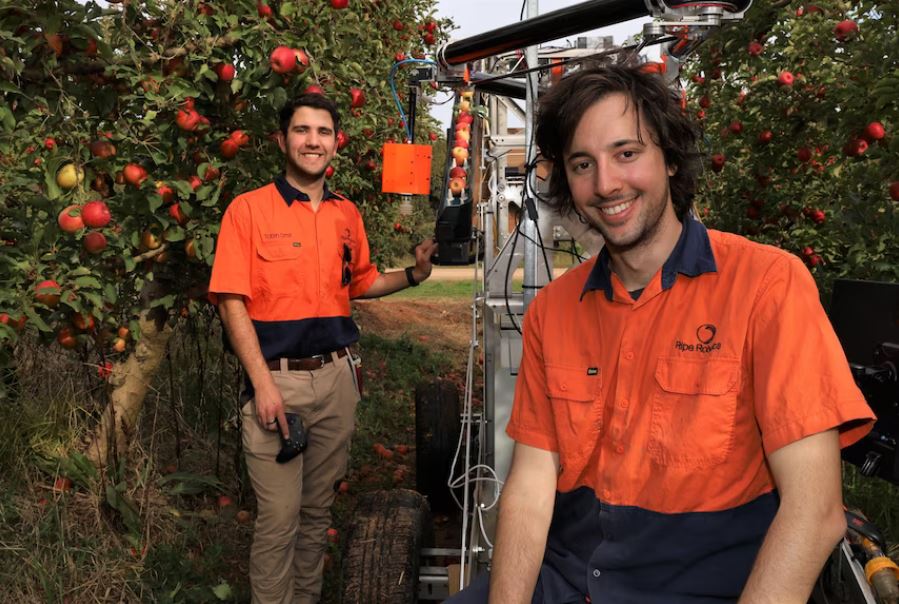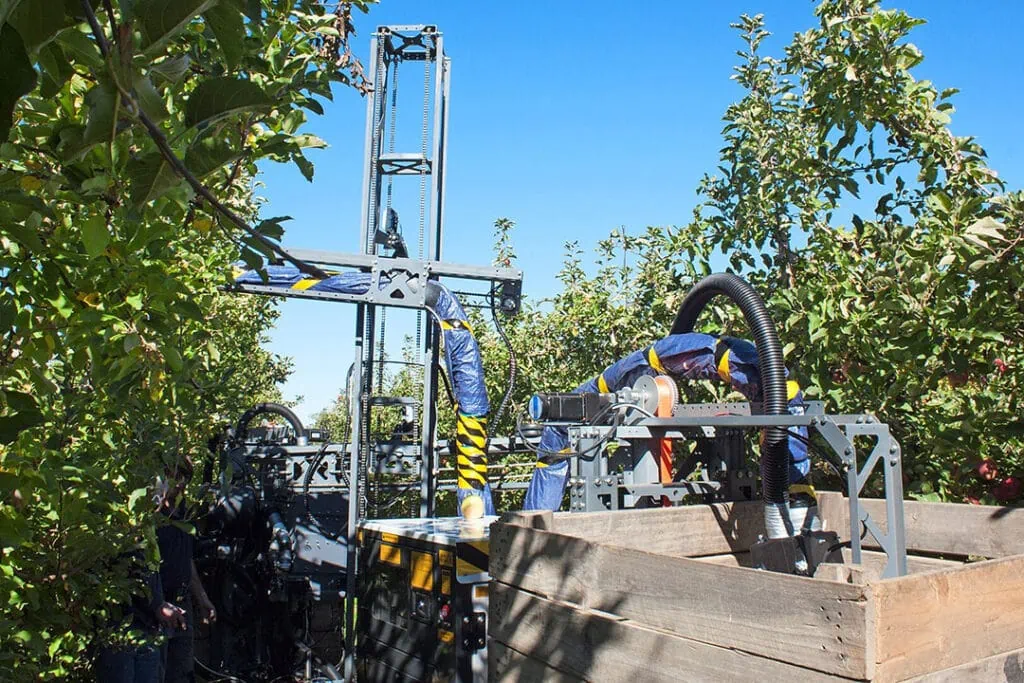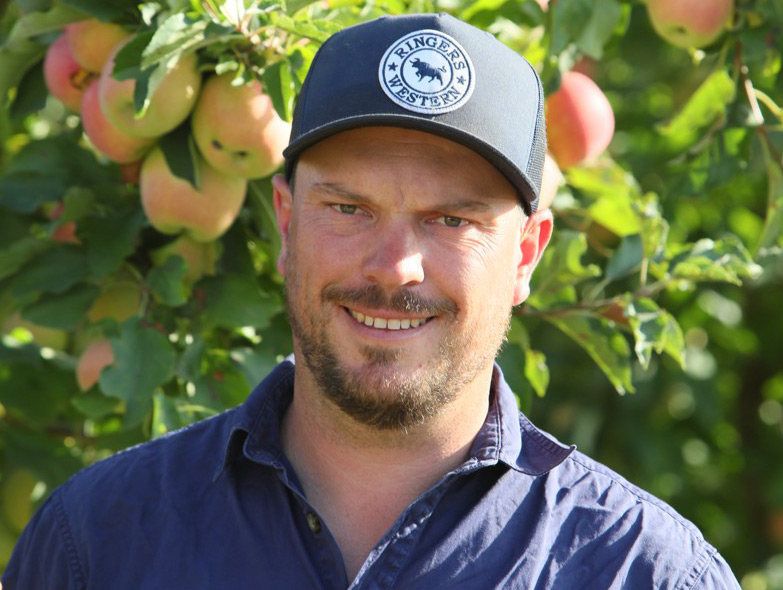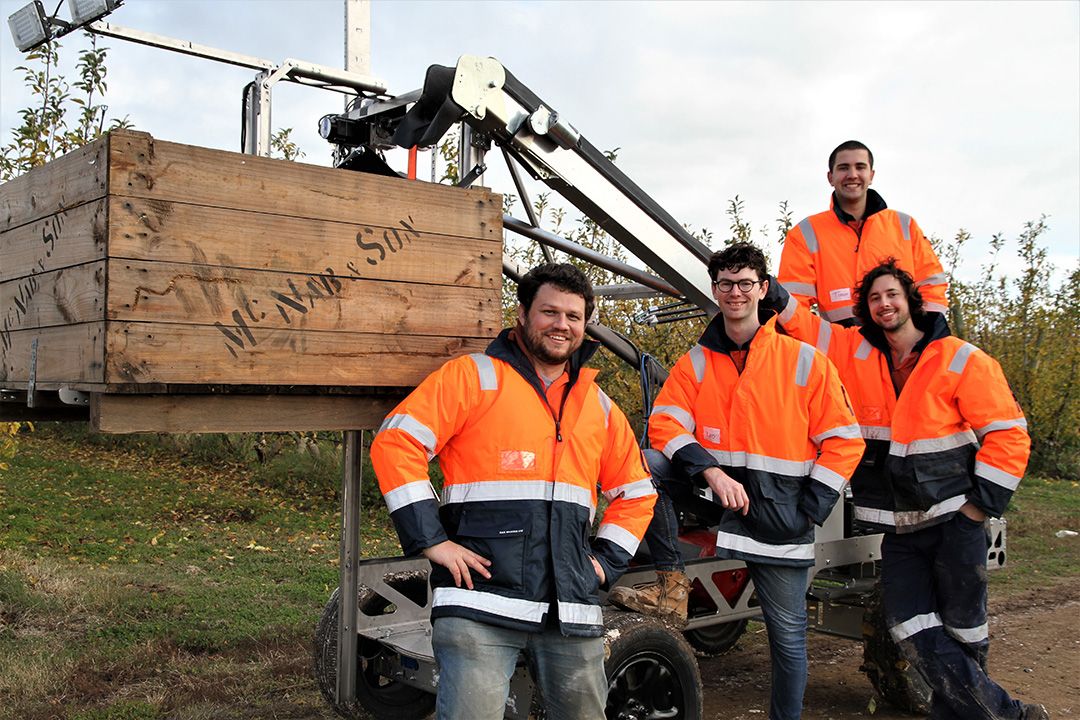Fruit growers join queue for award-winning Australian harvest robot

Mechatronics specialist Tobin Smit (left) and Ripe Robotics Chief Executive Officer Hunter Jay. Photo: Supplied
Farmers across the world are clamouring to get hold of the autonomous fruit harvesting robot in development by Australian company, Ripe Robotics, writes Sandra Godwin.
“There’s been people all over, some from America, Brazil and Israel,” said Ripe Robotics Chief Executive Officer Hunter Jay. “It’s really crazy. People are really keen for this, but we keep having to say we haven’t actually got the machine ready yet. It’s still in the first stages of commercialisation.”
Ripe Robotics’ third-generation picker, dubbed Eve, has aroused even greater interest since it was awarded Best Concept Field Robot in the category for outdoor harvesters at World FIRA – the world agricultural robotics forum – held in France and online in December.
Eve was up against two other finalists: the US-made TX Strawberry Harvester, backed by Kubota and Yamaha, and UK company Muddy Machines’ asparagus harvester, Sprout.
A seven-member international jury judged entries on a range of criteria, which included originality, feasibility, the potential to impact a farmer’s life, ease of farmer uptake and sustainability.

Ripe Robotics’ third-generation picker, dubbed Eve, has aroused even greater interest since it was awarded Best Concept Field Robot in the category for outdoor harvesters at World FIRA in 2021. Photo: Supplied
Hunter, who cofounded Ripe Robotics with Leopold Lucas three years ago, said the award was unexpected but welcome, and he hoped it would help open more doors in future to potential investors.
Eve is propelled by an electric drive along rows of fruit trees. It uses a combination of on-board cameras and algorithms to identify ripe fruit, which is picked with suction cups and transported in tubes to the bin.
The picking action is reminiscent of the fictional giant sandworm from Frank Herbert’s Dune novels, minus the terrifying teeth.
Eve has been tested in apple, stonefruit and citrus orchards in NSW and Victoria. The fourth generation, Newton, and any further iterations will be put through commercial trials in plums and apples in the Goulburn Valley and oranges at Griffith in the next two years.
Finding a big problem to solve
Hunter, who has a computer science degree and a background in artificial intelligence, said they set out to develop a solution to a major problem that wasn’t being addressed in Australia. They considered a range of industries, including mining and transport, before settling on agriculture.
“We were looking for a big problem not being addressed by any big companies,” he said. “We also wanted to be able to expand out from a narrow starting point. So if we can solve fruit picking with robots, then we can expand into doing other tasks like pruning and thinning, spraying and data analytics, all things that could be automated on orchards.”
Apart from improved cameras, the trend towards higher density “2D plantings” – where trees are espaliered along a trellis system to expose fruit to more consistent light levels – has helped make harvest automation more feasible.

Fifth generation Ardmona fruit grower Mitch McNab has worked closely with the Ripe Robotics team. Photo: Supplied
Fifth generation fruit grower Mitch McNab, who manages 97ha of stonefruit and apple orchards at Ardmona, near Shepparton, has worked closely with the Ripe Robotics team.
Mitch has long been interested in orchard automation, and was awarded a Nuffield scholarship in 2016 to study robotics in apple and pear production. That trip took him to see robots under development in the United States, Israel and New Zealand.
“Once I saw what Hunter was doing, in trying to manufacture an apple picking robot in Australia, I thought it would be a great opportunity for us to be a part of that,” he said. “It’s a huge way for us to allow us to export our produce and create almost a level playing field. For a long time, we’ve been able to command a premium for a superior product, whereas now there are other countries around the world that can produce a similar quality product to what we can for far less. Through robotics and labour-saving technologies or mechanisation, there’s a way that I think our industry can continue to go forward and still compete in those markets.”
Mitch said automation would not only reduce the cost of picking – which accounts for as much as half the cost of production – but slash waste and give growers peace of mind from knowing they would be able to harvest fruit at the right time.
It’s no secret that access to seasonal labour in Australia has been a problem for decades.
“If anything, the pandemic has reinforced that our reliance on labour is too high,” Mitch said. “We need to be able to grow things with less labour and I think that robotics is going to be the only way forward for us to do so.”
It’s a sentiment shared by producers in other major fruit-growing regions of the world.
California grower group Western Growers, which last year announced its aim to accelerate agricultural automation by 50 per cent within 10 years, released its first annual Global Harvest Automation Report in February.
The study found harvest automation was limited outside almonds “mainly due to the technical difficulties in replicating the human hand to harvest delicate crops”.
Ripe Robotics is part of the Western Growers Harvest Automation Initiative and Hunter said Vice President of Innovation Walt Duflock told them autonomous picking was essential to the industry’s future.
“He was saying that if they don’t have autonomous picking for most of the fruit that they look after in about five to 10 years, then they’re not going to have fruit grown in the US anymore,” Hunter said. “It’s just getting way too expensive.”

Members of the Ripe Robotics team: Michael Woods, Leopold Lucas, Tobin Smit and Hunter Jay. Photo: Supplied
How it started
The first Ripe Robotics prototype was built in 2019 using a shelf kit from Bunnings, chains, a motor and a camera, at a cost of about $3000. It was programmed to move an arm up and down and tap on an apple.
That was enough for them to demonstrate the concept and raise funds for further development.
Since then, the team has made the robots mobile and looked at different ways for it to hold and remove fruit from the tree.
Eve and Newton use suction cups to pull the fruit, which is then deposited by tube into a bin.
Hunter said that had worked well in smaller scale field trials, but they were discovering limitations in trying to scale up from picking a few hundred pieces of fruit to thousands. As well as experimenting with smaller suction cups, they’re testing finger-based grippers.
“It’s tricky because there’s a lot of variety in the fruit that we’re trying to pick up,” he said. “It might be the case that we have one end-effector that works very well with plums, and others for apples and oranges, but that’s not a problem.”
Rather than selling the robots, the plan is for Ripe Robotics to manage them on behalf of farmers who will pay a fee for each bin of fruit harvested.
“We’ll take the machine out, set it up, leave it on the farm and monitor and control it over the internet,” Hunter said. “So even though it’s left in the field alone, there’ll be someone getting alerts and watching through its cameras to make sure everything is working the way it should be.”
Unlike humans, they would be able to pick around the clock and cause less accidental damage to fruit.
Next steps
Commercial trials over the next two years will be an opportunity to improve the reliability of their machines and gather more of the data needed to inform the algorithms that determine when, where and how fruit is picked.
Hunter said they were collecting data on location, fruit size, colour and maturity for real-time monitoring. They also hope within two or three years to be able to report to growers on signs of disease and bird damage, and warn of potential irrigation problems.
“Even when fruit is not yet ready, we can let the robots walk up and down the rows, day or night,” he said. “They can just keep looking at the fruit to predict better and better when it’s going to be ready to harvest, or if there’s anything else the growers need to do to the trees to make that happen.”
Hunter said they were expecting one robot to be about as productive as one or two human fruit pickers, aiming for a piece of fruit to be picked every 1-4 seconds. Calculations indicated a fleet of up to 2000 would be enough to service most of Australia.
Mitch is excited by the potential.
“They’re well on the way,” he said. “It’s just going to take time to teach the machine and the algorithms to do what it needs to do. I’m hoping within the next couple of years, we’re at a point where we’re genuinely at a commercialisation stage.”
Update: In June 2023, Mitch was named Young Farmer of the Year at the 13th annual Kondinin Group and ABC Rural Australian Farmer of the Year awards. Read more here
